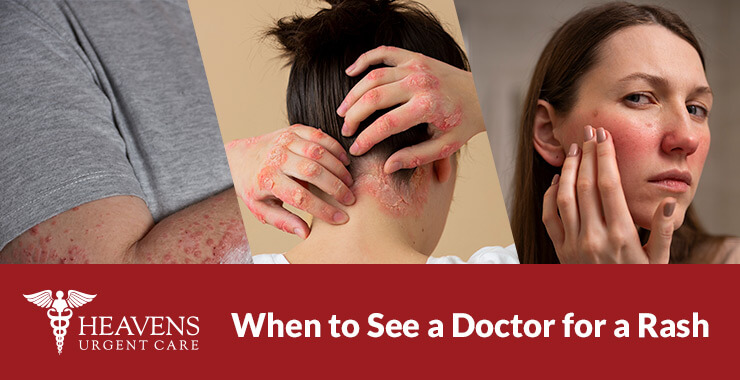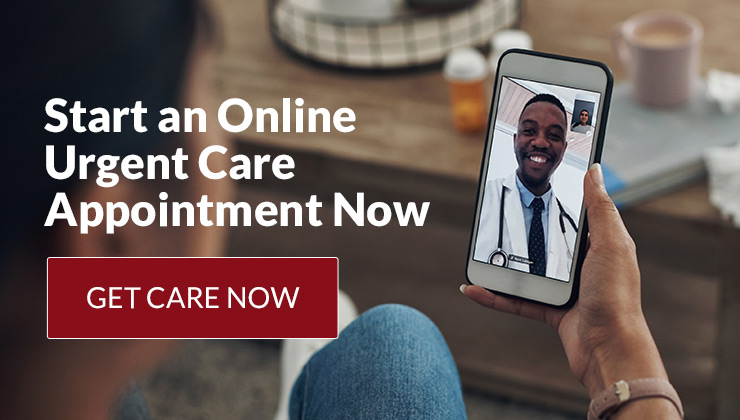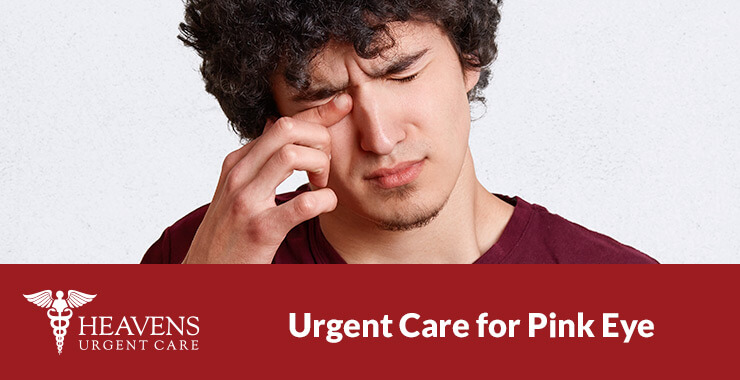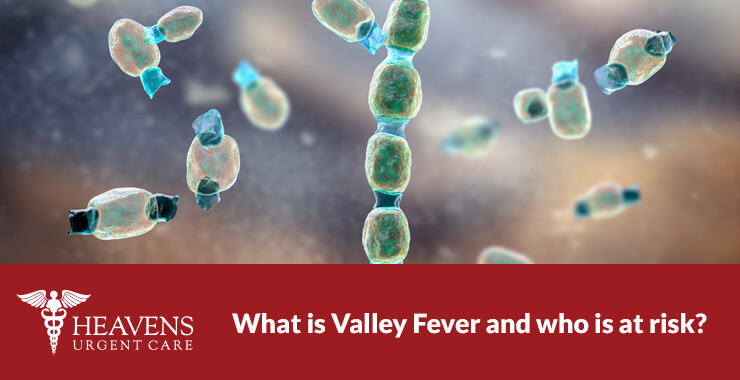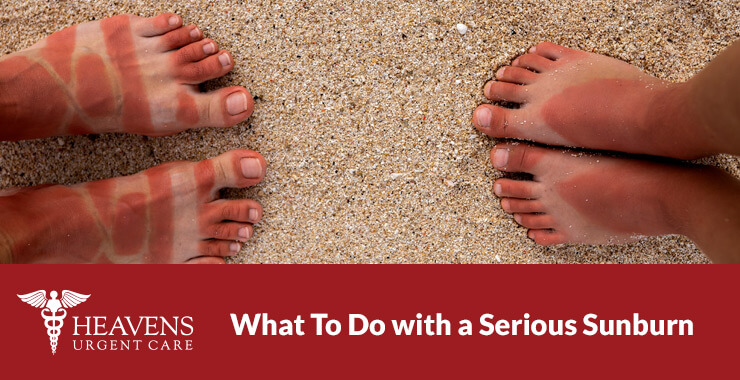The skin can tell us a lot about what’s happening in our bodies, so when a rash appears it’s a good idea to listen.
What is a Rash?
Rash is a term that describes skin irritation, discoloration, or textural changes that can appear as blotches, welts, or blisters. A rash can be red, itchy, scaly, or dry; and can occur in one area of skin or all over the body.
A rash can occur due to an immune system response, infection, irritant, toxin, environmental factors, or a combination of these.
Most rashes look similar and may seem easy to treat with over-the-counter oral antihistamines or hydrocortisone cream. However, it is not always that simple. Then there are rashes that have other accompanying symptoms that should be seen by a medical provider.
Common Rashes
Cellulitis
Cellulitis is a deep infection of the skin caused by bacteria. It usually affects the arms and legs but can be found in other areas of the body. This condition usually happens after some type of injury causes a skin break. Once the skin breaks, bacteria can enter and cause infection.
Chickenpox
Chickenpox is a highly contagious viral infection that causes an itchy, blister-like rash. It used to be a common childhood illness in the United States, especially in kids under age 12. It’s much rarer now, thanks to the varicella vaccine.
Contact Dermatitis
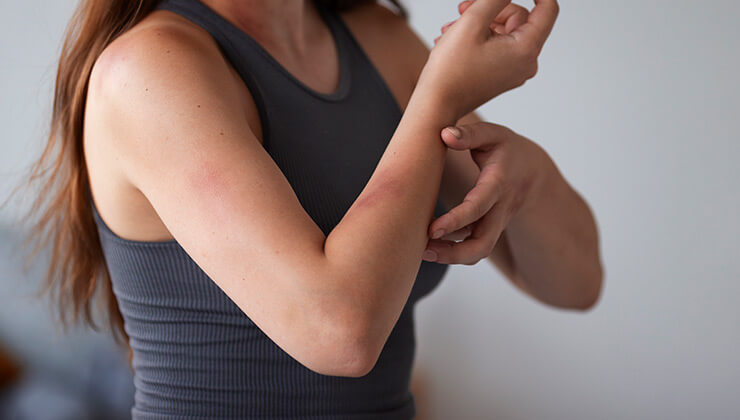
Contact dermatitis or allergic contact dermatitis is a skin condition that can be caused by contact with plants like poison ivy, jewelry, or cosmetics. This reaction can cause the skin to become itchy, red, swollen, and sore.
Eczema
Eczema is a condition that causes the skin to become itchy, red, and inflamed. Over 30 million Americans have some form of eczema. In adults it is usually seen on the neck, upper arms and back, elbow and knee creases, and back of the hands, feet, fingers and toes. The cause of eczema is not known, but it is thought to be caused by a combination of environmental and genetic factors.
Erythema multiforme
Erythema multiforme is a skin condition that is an allergic reaction to medicine or an infection. Symptoms appear as symmetrical, red, raised skin areas that can be found all over the body.
TIP: Take a photo of the rash as soon as you notice it. The image can be helpful when you come to your medical appointment, especially if the rash has changed.
Heat Rash
Heat rash can also be called prickly heat, sweat rash, or miliaria. It is considered a very itchy, but harmless skin rash. Heat rash is caused by the blockage of sweat ducts and appears as small red spots in places where sweat collects, such as the armpits, back, under the breasts, chest, groin, elbow creases, and back of the knees, and the waist.
Herpes
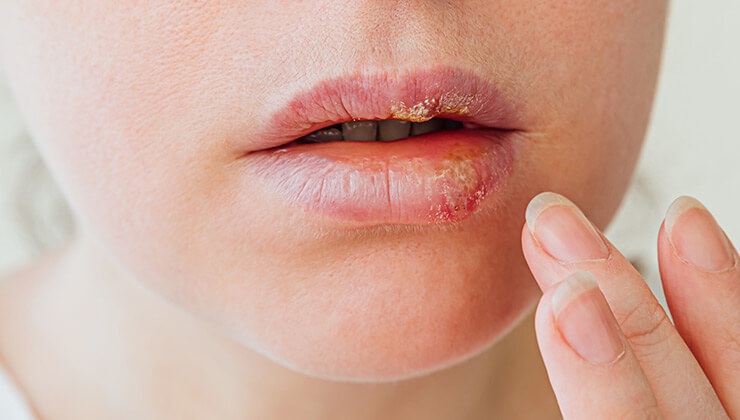
Herpes or, Herpes gladiatorum, also known as “mat herpes” is a skin infection caused by herpes simplex virus type 1 (HSV-1), the same virus that causes cold sores on the lips. A cluster (usually more than one) of clear, fluid-filled blisters appear that may be surrounded by redness — these blisters may or may not be painful. Blisters and lesions usually heal within 7 to 10 days.
Hives
Hives, also known as urticaria, is a common skin reaction that appears as itchy red welts. Hives are commonly caused by an allergic reaction, but can also be caused by heat, exercise, or stress. Treatment for hives usually involves taking antihistamines to help reduce itching and swelling.
Impetigo
Impetigo is a common bacterial skin infection caused by streptococcus or Staphylococcus aureus bacteria. The infection causes open, red, crusty lesions that may be either painful or itchy. Impetigo can occur alone, or with other symptoms like fever and malaise.
Insect Bites
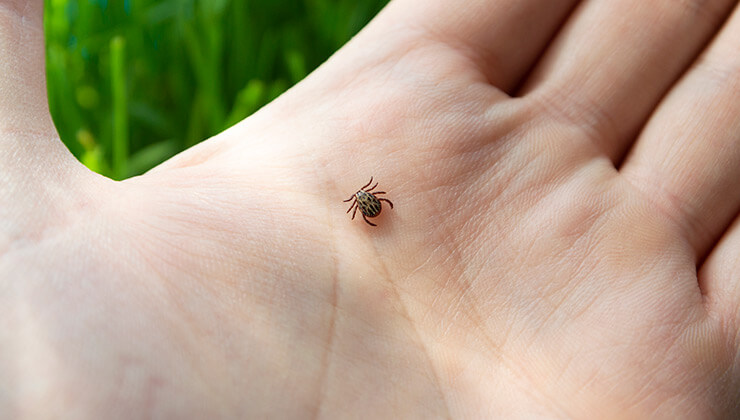
Insect bites including tick, flea, spider, and mosquito bites can result in a rash. Refer to our recent article, When Insect Bites and Stings Require Urgent Care, to learn more. https://heavensurgentcare.com/insect-bites-stings-urgent-care/
Lupus erythematosus
Lupus erythematosus is a chronic (long-lasting) autoimmune disease that can affect many parts of the body. Lupus occurs when the immune system, which normally helps protect the body from infection and disease, attacks its own tissues, including the skin.[1]
Psoriasis

Psoriasis is a red flaky rash that tends to show up in adulthood. Psoriasis is thought to be an immune system problem. Triggers include infections, stress, and cold.
Ringworm
Ringworm, or tinea corporis, is a fungal infection that causes a round, scaly, mildly itchy lesions. This type of fungus lives on the skin, hair, or nails.
Rosacea

Rosacea is an inflammatory skin condition that often begins with tendency to blush or flush more easily than other people, with symptoms generally appearing between the ages of 30-50 years. The small surface blood vessels (capillaries) of the skin enlarge, giving the appearance of a permanent flush. The forehead, cheeks and chin may develop yellow-headed pimples.
Seborrheic dermatitis
Seborrheic dermatitis is a common, chronic form of eczema/dermatitis. The condition tends to affect the sebaceous gland regions of the scalp, face, and trunk.
Dandruff
Dandruff (also called ‘pityriasis capitis’) is an uninflamed form of seborrheic dermatitis on the scalp.
Shingles
Shingles is a painful, blistering rash caused by the reactivation of the chickenpox virus. Shingles is usually preceded by a tingling feeling in the area affected, which can be anywhere on the body. Shingles is almost always found on one side of the body. If you think you have shingles, visit a medical provider within 3 days of the seeing the rash to get medication that can shorten the severity and duration of it.
TIP: One thing to be aware of is that a significant number of people are allergic to preparations with topical antibiotics, like bacitracin and neomycin. If the area you are treating becomes itchy or blistery, stop using the topical and contact your doctor.
When to Seek Medical Help for a Rash
Most rashes are not a sign of a dangerous condition, and it is safe to treat them at home. Still, it’s best to be informed because some rashes can be a warning sign of a serious medical condition.
An important rule of thumb is to seek medical help if the rash comes with other symptoms. If you have a rash and notice any of the following symptoms, see your doctor.
- You have a fever with the rash. If this is the case, go to the emergency room. A rash with a fever could signal an allergic reaction or an infection. A fever that is more than 100.4°F or 38°C. often means infection. Examples of rashes caused by infection include scarlet fever, measles, mononucleosis, and shingles.
- A rash that covers the body could also indicate an infection or an allergic reaction. Additionally, a rash that covers the body could be the result of a drug allergy or Lyme disease[2] (caused by a tick bite).
- Did the rash occur suddenly and spread rapidly? A fast-spreading rash is something you should never ignore.1 With some rashes, like shingles, you can sometimes watch the blistering lesions develop and spread before your eyes. The same can occur with a drug allergy. Allergies to medications are common, and some can be serious. If breathing becomes difficult, go to the ER, or call 911.
- The rash is circular. Many rashes are round, but only a handful cause a circular or coin-shaped rash seen in discoid eczema or ringworm. More concerning are circular “bullseye” rashes in which a central lesion is surrounded by a circular ring. A bullseye rash is characteristic of Lyme disease, an infection caused by tick bites that, if left untreated, can lead to chronic fatigue, reactive arthritis, and mood or memory problems.
- If your rash is made up of blisters, or if the rash turns into open sores, it could be the result of an allergic reaction, a reaction to medication, or an internal cause. Rashes that are characterized by the formation of blisters, both small and large, include chickenpox, shingles, and genital herpes.
- Painful rashes should quickly be evaluated by a physician. Pay attention to whether the rash is itchy or painful. Seek medical treatment for painful rashes as they may be a sign of a potentially serious but treatable infection like shingles or genital herpes.
- The rash is infected. Rashes that are eruptive (they break open or burst) leave the underlying tissues vulnerable to bacterial infections. Signs of an infected rash are yellow or green fluid, swelling, crusting, pain, and warmth around the rash, or a red streak coming from the rash. People with herpes, shingles, chickenpox, eczema, and psoriasis are especially vulnerable to this unless they make effort to keep the broken skin clean.
- If you have a rash and are having trouble breathing this is considered a serious medical emergency. If this happens to you, call 9-1-1 or go to an ER right away. A sudden outbreak of rash or hives outbreak accompanied by shortness of breath and/or wheezing are classic symptoms of anaphylaxis. In addition to rash and breathing problems, symptoms of anaphylaxis may include diarrhea, nausea or vomiting, dizziness or fainting, and swelling of the face, neck, or tongue.
- Did the rash begin at the site of an injury? An animal bite (or human bite, especially with toddlers) or other wound that leads to a rash is a reason to get it checked out.
Rashes happen for many reasons, including allergies and medications. They can also show up on the skin from bacterial, fungal, viral, or parasitic infections and other diseases.
Make certain that you are aware of the signs and symptoms that may require medical attention and remember that a virtual, online visit (especially if you suspect that the rash is contagious) is a great alternative if you need to feel better… fast.
Generally, you should seek medical care for a rash if:
- Is accompanied by difficulty breathing.
- Develops suddenly and/or spreads rapidly.
- Causes blistering, swelling, or bruising.
- Is circular or “bullseye” shaped.
- Shows signs of infection.
- Is accompanied by fever, chills, or other symptoms.
- Is itchy, painful, or covers a large area of your body.
[1] Systemic Lupus Erythematosus (Lupus)
[2] Lyme Disease

